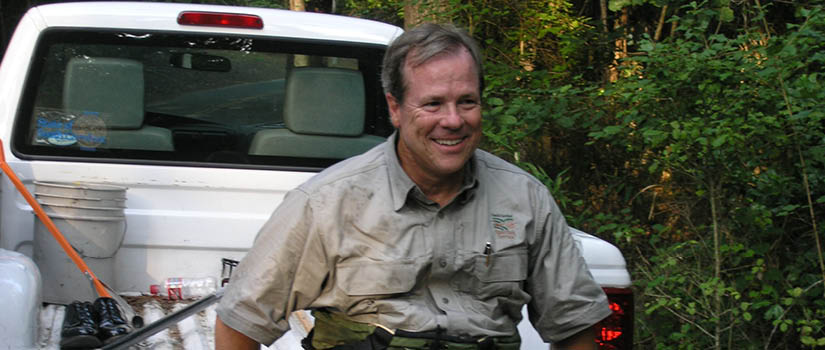While the exponential spread of the Delta variant of the COVID-19 virus is concerning, the economic impact of the rising case numbers should not be as detrimental as industries experienced in 2020.
As the COVID-19 pandemic consumed the U.S. in March 2020, no one fully understood the magnitude of impacts it would have on industries from restaurants and college campuses to libraries and hotels.
Alumnus Duane Parrish (’81 management and marketing) was watching the shutdown especially closely as the South Carolina Department of Parks, Recreation & Tourism (SCPRT) director, a role he’s held for more than a decade. Parrish was named the national 2019 State Tourism Director of the Year by the U.S. Travel Association just ahead of the pandemic.
Read on as Parrish discusses COVID-19 and its impact on South Carolina’s tourism industry.
What were COVID-19’s impacts on South Carolina’s tourism industry?
At the beginning of the pandemic, every sector of the tourism industry began to see
an immediate and negative impact. Tourism business began to decline quickly in March
2020. By April, there was so much uncertainty, and nearly all non-essential travel
seemed to stop overnight. Statewide hotel occupancy in South Carolina dropped to a
historic low of 26.4 percent, a 63 percent decrease compared to April 2019. I can
tell you, as a lifelong hotelier, that type of drop is alarming. It wasn’t just hotels
that saw that type of decrease. Everything bottomed out in April 2020, not just in
South Carolina, but across the nation. Tourism business all but stopped for about
a month.
The first sectors to see signs of recovery, which began in mid to late spring, were the outdoor recreation sector and short-term rentals like Airbnb. Consumers felt more comfortable resuming these types of tourism activities because they naturally allowed for social distancing. Golf courses, which were never mandated to close in South Carolina, began seeing significant increases in business — a trend that has continued throughout the pandemic. The same was true for outdoor recreation venues like state and local parks. Our State Parks were closed for a little over a month in late March. When they reopened on May 1, they started experiencing record-level visitation almost right away. South Carolina’s State Parks generated $5 million for three consecutive months from May through July 2020, compared to a monthly average of $3.9 million during the same period in 2019.
Hotels saw a more gradual recovery throughout the summer and fall, as did other types of attractions and restaurants. Only State Parks revenue, golf-related data and short-term rental metrics returned to pre-pandemic levels during 2020. All told, SCPRT estimates that the state lost approximately $6 billion in tourism spending in 2020, with domestic visitor spending down 31 percent and international visitor spending down 80 percent.
What steps did the South Carolina Department of Parks, Recreation and Tourism take
to try to minimize the effects the pandemic had on the state’s tourism industry?
When the pandemic first began, SCPRT paused its advertising efforts and began to develop
short- and long-term tourism business recovery marketing strategies. When many consumers
couldn’t or wouldn’t travel, SCPRT’s marketing efforts focused on keeping South Carolina
top of mind for consumers — encouraging them to go ahead and make plans for their
next vacation through the “Dream Now, Discover Later” campaign. As consumers began
to travel more, SCPRT shifted its marketing focus to “When You’re Ready, We’re Ready,”
visually emphasizing activities that allowed for social distancing (e.g., golf, outdoor
recreation) and also providing assurances of the ability to travel safely in South
Carolina (e.g., showing servers and chefs wearing masks, showing hotel rooms being
cleaned).
SCPRT also worked with state officials to secure additional funding for both state and local tourism recovery marketing efforts. In October 2020, SCPRT received $20 million from the State’s Response Reserve Funds. Of these funds, approximately $15.6 million was distributed to local or regional destination marketing organizations for tourism recovery paid advertising purchases. SCPRT was also awarded a $3 million grant from the U.S. Department of Commerce in December 2020 to boost the state’s recovery advertising efforts.
In the first half of 2021, South Carolina total occupancy, including hotels and short-term
rentals, is up 30 percent compared to the same period in 2020. And we’re outpacing
the U.S. average of
24 percent in terms of occupancy growth. South Carolina lodging revenue for January
through June 2021 is $828 million higher than the same period in 2020 and $125 million
higher than the same period in 2019. Hotel occupancy is a good pulse check for the
tourism industry because typically, as go hotels, so goes the rest of the industry.
We’re getting heads back in the beds, and the rest will follow.
What is the long-term impact of COVID-19 on the states’ tourism industries?
We’ve seen various impacts on different sectors of the tourism industry. For example,
some hotels and restaurants have implemented operational changes for more contactless
service when checking in or ordering food. These changes have been introduced, in
part, to limit the amount of physical contact between staff and consumers but also
in response to the labor shortage the tourism industry has experienced in 2021.
We’ve seen other impacts that we hope will be long-lasting, such as the significant increases in golf rounds and State Parks visitation. A lot of consumers, when there was little else they could do, discovered or rediscovered outdoor recreation. They got their golf clubs out of the attic or garage. They bought hiking shoes, kayaks and RVs. For a while you couldn’t find a bicycle to purchase at any retailer. That’s a trend that we hope will continue far into the future.
The other long-term impact — and, honestly, it’s one I hope never comes to bear significance — is that we’re more prepared for how to respond to disasters like the COVID-19 pandemic. We’re not out of the woods completely yet, but we know we’re on the right path.
